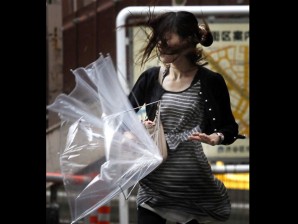Typhoon smashes into Japan, 4 already dead

TYPHOON ROKE A woman struggles in strong wind caused by approaching typhoon in Tokyo, Japan, Wednesday, Sept. 21, 2011. The powerful typhoon was bearing down on Japan's tsunami-ravaged northeastern coast Wednesday, approaching a nuclear power plant crippled in that disaster and prompting calls for the evacuation of more than a million people. AP Photo/Shuji Kajiyama
TOKYO—A powerful typhoon smashed into disaster-ravaged Japan on Wednesday, having already killed at least four people, less than a month after a vicious storm left 100 dead.
Typhoon Roke, whose maximum speed was recorded at 216 kilometers (130 miles) per hour, made landfall near Hamamatsu, central Japan, at about 2 p.m. (0500 GMT) and was on course to move northeast across the major island of Honshu.
More than a million people were initially warned to leave their homes over fears that the expected torrential rains would cause widespread flooding.
The typhoon comes just months after a devastating earthquake and tsunami sparked a crisis at the Fukushima nuclear plant, where workers were frantically reinforcing the facility against the storm.
Four people have so far been found dead in central and western Japan, while two people are missing in the central prefecture of Gifu, including a young boy who disappeared on his way home from primary school.
Article continues after this advertisementA tornado warning was temporarily raised across the Tokyo area, but expired a few hours after it was issued.
Article continues after this advertisementMany evacuation advisories were dropped by Wednesday lunchtime, but remained in force for around 330,000 people nationwide.
It was not clear how many people had followed the advice, which falls short of mandatory evacuation orders.
Auto giant Toyota said it was temporarily shutting 11 of its 15 Japanese plants, which lie in the path of the storm.
“The second (afternoon) shift is stopped. (It is) not resuming today. No decision has been made for tomorrow,” company spokesman Dion Corbert told AFP.
The affected plants are all in Aichi prefecture in central Japan.
Japan’s top heavy machinery manufacturer Mitsubishi Heavy Industries temporarily closed five of its aviation and engine plants in central Japan due to the storm, a company spokesman said.
Roke is expected to heap more misery on a country that has been lashed by natural disasters this year.
The huge quake and tsunami of March 11 left 20,000 people dead or missing and devastated hundreds of kilometers of coastline, destroying whole communities and wreaking billions of dollars of damage.
The Fukushima Daiichi nuclear power plant was sent into meltdown after its cooling systems were swamped by the waves, sending radiation into the air, sea and food chain in the planet’s worst atomic disaster since Chernobyl.
Earlier this month, Typhoon Talas slammed into central Japan, killing around 100 people in the deadliest storm to hit the country for over 30 years.
Heavy downpours caused flash flooding and massive landslides that swept away buildings and people.
By the time it hit the coastline on Wednesday, Typhoon Roke was moving at a speed of 45 kilometers per hour. Winds near its center were estimated at up to 162 kilometers per hour.
“The rain and wind is raging out there and people on the street were staggering,” Yoshinori Ito, a spokesman with Hamamatsu City, said by phone.
The storm was expected to travel northeast, possibly toward the crippled Fukushima nuclear plant, where workers are still battling to control persistent radiation leaks.
“We have taken every possible measure against the typhoon” at Fukushima Daiichi, said Naoki Tsunoda, a spokesman for Tokyo Electric Power Co., the operator of the stricken power plant.
“We have tied down cables and hoses while fixing equipment so that radioactive materials will not spread (in violent winds),” he said, adding operations on the ground and at sea had been suspended.
He said workers had also fixed tarpaulin over spots in buildings where rain could enter.
The typhoon has already brought torrential rain and some flooding, with TV footage showing residents walking through streets knee-deep in water.
A number of expressways have been closed, while more than 200 flights are to be cancelled for Wednesday, according to NHK.
Media reports said a 66-year-old man in Nagoya fell to his death while unblocking a drainpipe and a 71-year-old man in Karatsu city in southern Japan drowned in high ocean waves while trying to moor a fishing boat.